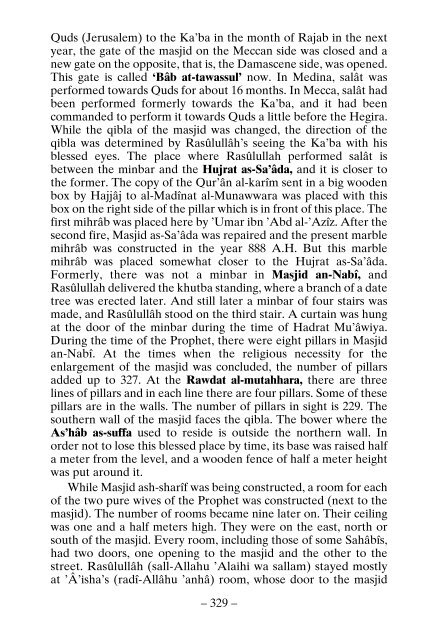Advice for the Muslim
ADVICE FOR THE MUSLIM Brief passages from the reputed books of ahl as-sunnat scholars are quoted for refuting corrupt Wahhabi and la-madhhabiyya beliefs.
ADVICE FOR THE MUSLIM
Brief passages from the reputed books of ahl as-sunnat scholars are quoted for refuting corrupt Wahhabi and la-madhhabiyya beliefs.
Create successful ePaper yourself
Turn your PDF publications into a flip-book with our unique Google optimized e-Paper software.
Quds (Jerusalem) to <strong>the</strong> Ka’ba in <strong>the</strong> month of Rajab in <strong>the</strong> next<br />
year, <strong>the</strong> gate of <strong>the</strong> masjid on <strong>the</strong> Meccan side was closed and a<br />
new gate on <strong>the</strong> opposite, that is, <strong>the</strong> Damascene side, was opened.<br />
This gate is called ‘Bâb at-tawassul’ now. In Medina, salât was<br />
per<strong>for</strong>med towards Quds <strong>for</strong> about 16 months. In Mecca, salât had<br />
been per<strong>for</strong>med <strong>for</strong>merly towards <strong>the</strong> Ka’ba, and it had been<br />
commanded to per<strong>for</strong>m it towards Quds a little be<strong>for</strong>e <strong>the</strong> Hegira.<br />
While <strong>the</strong> qibla of <strong>the</strong> masjid was changed, <strong>the</strong> direction of <strong>the</strong><br />
qibla was determined by Rasûlullâh’s seeing <strong>the</strong> Ka’ba with his<br />
blessed eyes. The place where Rasûlullah per<strong>for</strong>med salât is<br />
between <strong>the</strong> minbar and <strong>the</strong> Hujrat as-Sa’âda, and it is closer to<br />
<strong>the</strong> <strong>for</strong>mer. The copy of <strong>the</strong> Qur’ân al-karîm sent in a big wooden<br />
box by Hajjâj to al-Madînat al-Munawwara was placed with this<br />
box on <strong>the</strong> right side of <strong>the</strong> pillar which is in front of this place. The<br />
first mihrâb was placed here by ’Umar ibn ’Abd al-’Azîz. After <strong>the</strong><br />
second fire, Masjid as-Sa’âda was repaired and <strong>the</strong> present marble<br />
mihrâb was constructed in <strong>the</strong> year 888 A.H. But this marble<br />
mihrâb was placed somewhat closer to <strong>the</strong> Hujrat as-Sa’âda.<br />
Formerly, <strong>the</strong>re was not a minbar in Masjid an-Nabî, and<br />
Rasûlullah delivered <strong>the</strong> khutba standing, where a branch of a date<br />
tree was erected later. And still later a minbar of four stairs was<br />
made, and Rasûlullâh stood on <strong>the</strong> third stair. A curtain was hung<br />
at <strong>the</strong> door of <strong>the</strong> minbar during <strong>the</strong> time of Hadrat Mu’âwiya.<br />
During <strong>the</strong> time of <strong>the</strong> Prophet, <strong>the</strong>re were eight pillars in Masjid<br />
an-Nabî. At <strong>the</strong> times when <strong>the</strong> religious necessity <strong>for</strong> <strong>the</strong><br />
enlargement of <strong>the</strong> masjid was concluded, <strong>the</strong> number of pillars<br />
added up to 327. At <strong>the</strong> Rawdat al-mutahhara, <strong>the</strong>re are three<br />
lines of pillars and in each line <strong>the</strong>re are four pillars. Some of <strong>the</strong>se<br />
pillars are in <strong>the</strong> walls. The number of pillars in sight is 229. The<br />
sou<strong>the</strong>rn wall of <strong>the</strong> masjid faces <strong>the</strong> qibla. The bower where <strong>the</strong><br />
As’hâb as-suffa used to reside is outside <strong>the</strong> nor<strong>the</strong>rn wall. In<br />
order not to lose this blessed place by time, its base was raised half<br />
a meter from <strong>the</strong> level, and a wooden fence of half a meter height<br />
was put around it.<br />
While Masjid ash-sharîf was being constructed, a room <strong>for</strong> each<br />
of <strong>the</strong> two pure wives of <strong>the</strong> Prophet was constructed (next to <strong>the</strong><br />
masjid). The number of rooms became nine later on. Their ceiling<br />
was one and a half meters high. They were on <strong>the</strong> east, north or<br />
south of <strong>the</strong> masjid. Every room, including those of some Sahâbîs,<br />
had two doors, one opening to <strong>the</strong> masjid and <strong>the</strong> o<strong>the</strong>r to <strong>the</strong><br />
street. Rasûlullâh (sall-Allahu ’Alaihi wa sallam) stayed mostly<br />
at ’Â’isha’s (radî-Allâhu ’anhâ) room, whose door to <strong>the</strong> masjid<br />
– 329 –

















